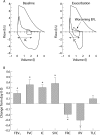COPD exacerbations . 3: Pathophysiology
- PMID: 16565268
- PMCID: PMC2104611
- DOI: 10.1136/thx.2005.041830
COPD exacerbations . 3: Pathophysiology
Abstract
Exacerbations of chronic obstructive pulmonary disease (COPD) are associated with increased morbidity and mortality. The effective management of COPD exacerbations awaits a better understanding of the underlying pathophysiological mechanisms that shape its clinical expression. The clinical presentation of exacerbations of COPD is highly variable and ranges from episodic symptomatic deterioration that is poorly responsive to usual treatment, to devastating life threatening events. This underscores the heterogeneous physiological mechanisms of this complex disease, as well as the variation in response to the provoking stimulus. The derangements in ventilatory mechanics, muscle function, and gas exchange that characterise severe COPD exacerbations with respiratory failure are now well understood. Critical expiratory flow limitation and the consequent dynamic lung hyperinflation appear to be the proximate deleterious events. Similar basic mechanisms probably explain the clinical manifestations of less severe exacerbations of COPD, but this needs further scientific validation. In this review we summarise what we have learned about the natural history of COPD exacerbations from clinical studies that have incorporated physiological measurements. We discuss the pathophysiology of clinically stable COPD and examine the impact of acutely increased expiratory flow limitation on the compromised respiratory system. Finally, we review the chain of physiological events that leads to acute ventilatory insufficiency in severe exacerbations.
Conflict of interest statement
Competing interests: none declared.
References
Publication types
MeSH terms
LinkOut - more resources
Full Text Sources
Other Literature Sources
Medical




